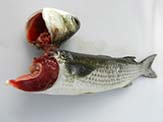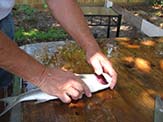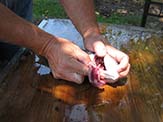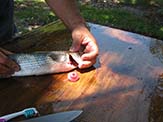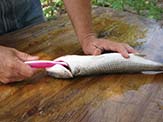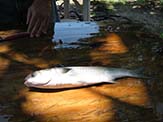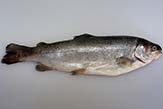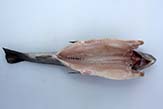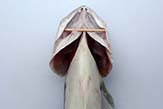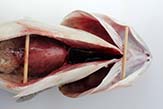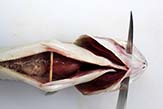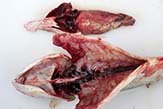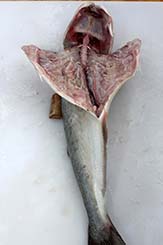Meats and Sausages
Bleeding Fish
Bleeding fish is a phrase used to describe the removal of blood from fish. It should be performed as soon as possible when the fish are caught. Bleeding fish is performed to preserve the quality and appearance of the meat. Mullet are bled by snapping the head of the body then sticking the index finger and middle fingers in their gills and ripping them out. The blood immediately starts to squirt out for about 10 seconds. There are a few main advantages to bleeding mullet: it results in whiter meat when filleted, there is a less fishy flavor present, and the bacteria spoilage is slowed down.
Some fish have little scales; in others, the number will vary, for example, European King Carp have a few scales on top, but wild carp is fully covered with them. Scales can be removed with a scale-removing scraper or the back of the knife going from the tail toward the head. The scales will fly everywhere, so the operation is best performed outside or by placing the fish in a large plastic bag.
Gibbing and Bleeding Fish
The entrails can be removed without cutting fish. This procedure is often used for baking stuffed fish and is known as gibbing. By inserting a knife in the gill region, the gills and guts can be removed with fingers.
Cutting the Chin Membrane
The fastest way of gutting most fish is by cutting off the head and splitting the belly. However, for visual effects, we may want the head to be attached to the body. The gills and the entrails can be removed by cutting into the area under the chin that joins the bottom of the two gill openings. Then, cut the belly cavity without cutting the intestinal tract. Now, the gills and entrails can be pulled out. Trout, which is sold in supermarkets is prepared that way. This can be further simplified by splitting the belly from the vent forward. Many fish can be prepared this way, although some rock fish have such hard jaws that the method becomes impractical.

